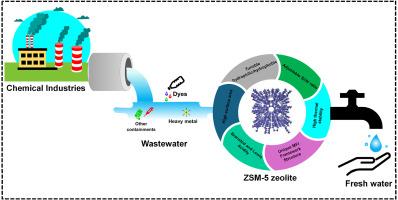Recent advances in ZSM-5 zeolite for multi-pollutant removal from water: A mini review
IF 4.7
3区 材料科学
Q1 CHEMISTRY, APPLIED
引用次数: 0
Abstract
Water pollution has emerged as a major global environmental challenge, largely due to the discharge of untreated wastewater containing a wide range of contaminants such as heavy metals, dyes, pharmaceuticals, oils, and minerals into natural water bodies. To mitigate this issue, various treatment techniques have been explored, with adsorption standing out as one of the most effective and economically feasible approaches for wastewater remediation. Although numerous adsorbents have been developed for pollutant removal, the search for materials that are not only highly efficient but also reusable and environmentally friendly remains a central research focus. In this context, nanomaterials with tunable physicochemical properties offer significant potential, enabling the design of adsorbents with high selectivity and performance. Among various advanced materials, ZSM-5 a high-silica zeolite, have attracted considerable attention due to their high surface area, adjustable porosity, chemical and thermal stability, ease of functionalization, and excellent regeneration capabilities. However, comprehensive reviews detailing recent advances in ZSM-5-based adsorbents for wastewater treatment are still scarce. This review aims to fill that gap by presenting recent developments in ZSM-5 zeolite-based composites for water treatment. It focuses on various modification strategies aimed at enhancing adsorption performance and assesses their effectiveness in removing a broad spectrum of pollutants, including dyes, heavy metals, herbicides, and pharmaceuticals. By consolidating recent advancements, it offers a comprehensive overview of the emerging role of ZSM-5 composites in advancing wastewater treatment technologies.

ZSM-5沸石去除水中多种污染物的研究进展
水污染已经成为一个主要的全球环境挑战,主要是由于未经处理的废水含有各种污染物,如重金属、染料、药物、油和矿物质排放到自然水体中。为了缓解这一问题,人们已经探索了各种处理技术,其中吸附是废水修复中最有效和经济可行的方法之一。虽然已经开发了许多用于去除污染物的吸附剂,但寻找不仅高效而且可重复使用和环境友好的材料仍然是研究的中心焦点。在这种情况下,具有可调物理化学性质的纳米材料提供了巨大的潜力,使设计具有高选择性和高性能的吸附剂成为可能。在各种先进材料中,高硅沸石ZSM-5因其高表面积、可调节孔隙度、化学和热稳定性、易于功能化和优异的再生能力而备受关注。然而,详细介绍基于zsm -5的吸附剂用于废水处理的最新进展的综合综述仍然很少。本文旨在通过介绍用于水处理的ZSM-5沸石基复合材料的最新进展来填补这一空白。它侧重于各种改性策略,旨在提高吸附性能,并评估其在去除广泛的污染物,包括染料,重金属,除草剂和药物的有效性。通过巩固最近的进展,它提供了ZSM-5复合材料在推进废水处理技术的新兴作用的全面概述。
本文章由计算机程序翻译,如有差异,请以英文原文为准。
求助全文
约1分钟内获得全文
求助全文
来源期刊

Microporous and Mesoporous Materials
化学-材料科学:综合
CiteScore
10.70
自引率
5.80%
发文量
649
审稿时长
26 days
期刊介绍:
Microporous and Mesoporous Materials covers novel and significant aspects of porous solids classified as either microporous (pore size up to 2 nm) or mesoporous (pore size 2 to 50 nm). The porosity should have a specific impact on the material properties or application. Typical examples are zeolites and zeolite-like materials, pillared materials, clathrasils and clathrates, carbon molecular sieves, ordered mesoporous materials, organic/inorganic porous hybrid materials, or porous metal oxides. Both natural and synthetic porous materials are within the scope of the journal.
Topics which are particularly of interest include:
All aspects of natural microporous and mesoporous solids
The synthesis of crystalline or amorphous porous materials
The physico-chemical characterization of microporous and mesoporous solids, especially spectroscopic and microscopic
The modification of microporous and mesoporous solids, for example by ion exchange or solid-state reactions
All topics related to diffusion of mobile species in the pores of microporous and mesoporous materials
Adsorption (and other separation techniques) using microporous or mesoporous adsorbents
Catalysis by microporous and mesoporous materials
Host/guest interactions
Theoretical chemistry and modelling of host/guest interactions
All topics related to the application of microporous and mesoporous materials in industrial catalysis, separation technology, environmental protection, electrochemistry, membranes, sensors, optical devices, etc.
 求助内容:
求助内容: 应助结果提醒方式:
应助结果提醒方式:


